Recent lockdowns have led to many people picking up outdoor guides and rediscovering the joy of nature. With beautiful and diverse wildlife across the country to discover, who would want to stay indoors?
Although captivating, the natural world is facing pressure in the form of wildlife trade. Hundreds of live animals are traded each day. In 2003 alone, over 7.5 million animals were loaded onto boats, and shipped across the globe!
But where do the animals go? And what are they used for? To answer those questions, we dove into data from the CITES Trade Database from 1975-2021 on the trade of live animals. Here’s what we found…
How Many Wildlife Trades Are Taking Place?
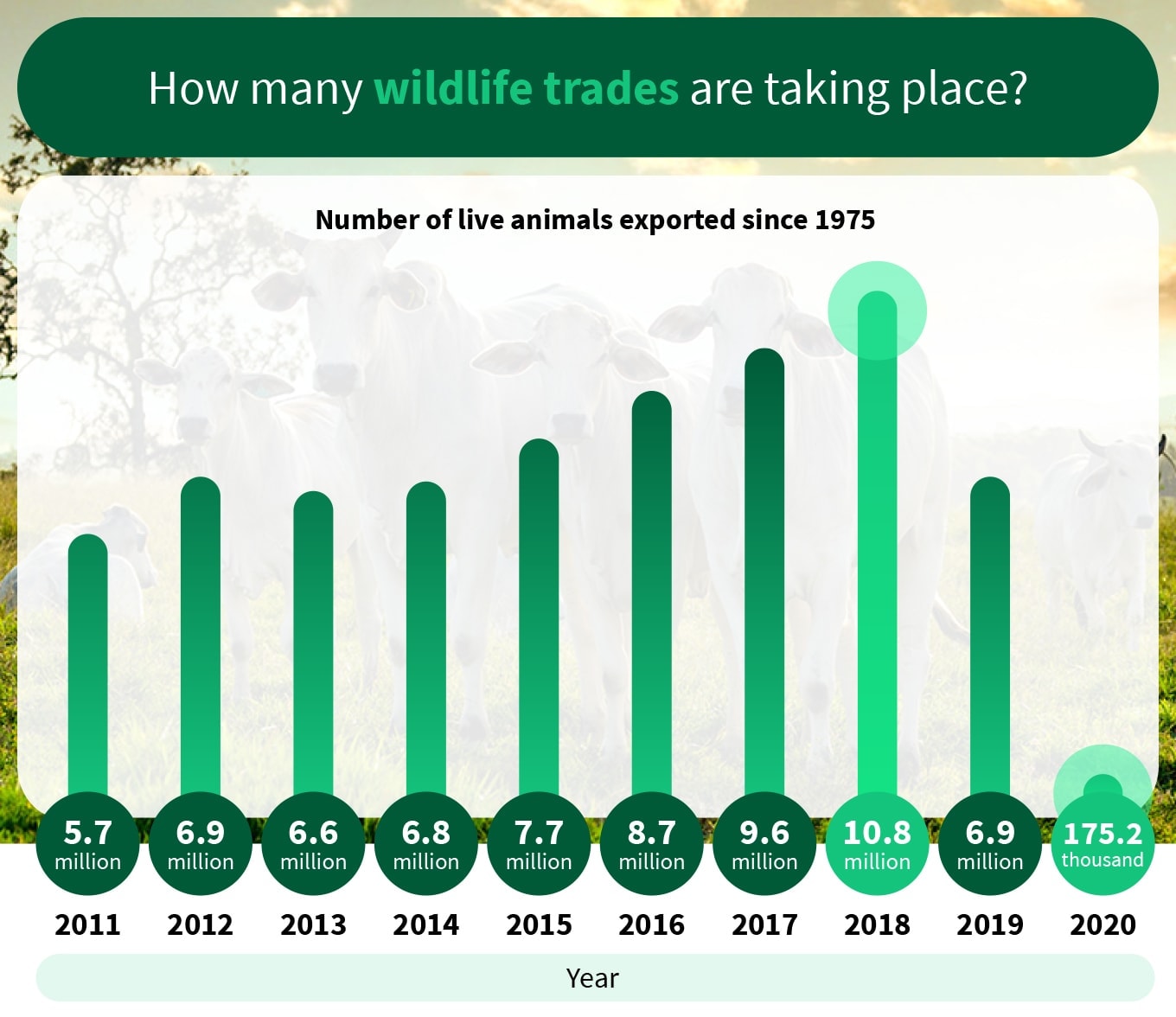
Share This Image On Your Site
<a href="https://outforia.com/wildlife-trades/"><img style="width:100%;" src="https://outforia.com/wp-content/uploads/2021/10/4-how-many.jpg"></a><br> Wildlife Trades Infographic by <a href="https://outforia.com">Outforia</a>Due to the growing consumer demand for animal products in the form of clothing, food and accessories the wildlife trade is vast and profitable.
Wildlife trading has been wide-scale since the 1990s, however, it reached its peak from 1999-2003 when around 7 million live animals were traded each year. Since then the biggest spike was in 2018 which was the biggest year for live animal trades.
In total, around 200 million live animal trades have taken place since 1975 and the trade is largely dominated by a few influential countries.
Although in 2006 just over 5 million live animals were exported, compared to 6.3 million the previous year. The downward trend came alongside the introduction of the CITES 2006 Commission Regulation.
The mandate introduced a standardized application process for countries to be granted permits and certificates, which made the live animal trade a more strictly regulated process. Rules on granting such documents tightened and protections for animals born and bred in captivity were introduced.
The Countries That Exported The Most Live Animals In The Last 46 Years
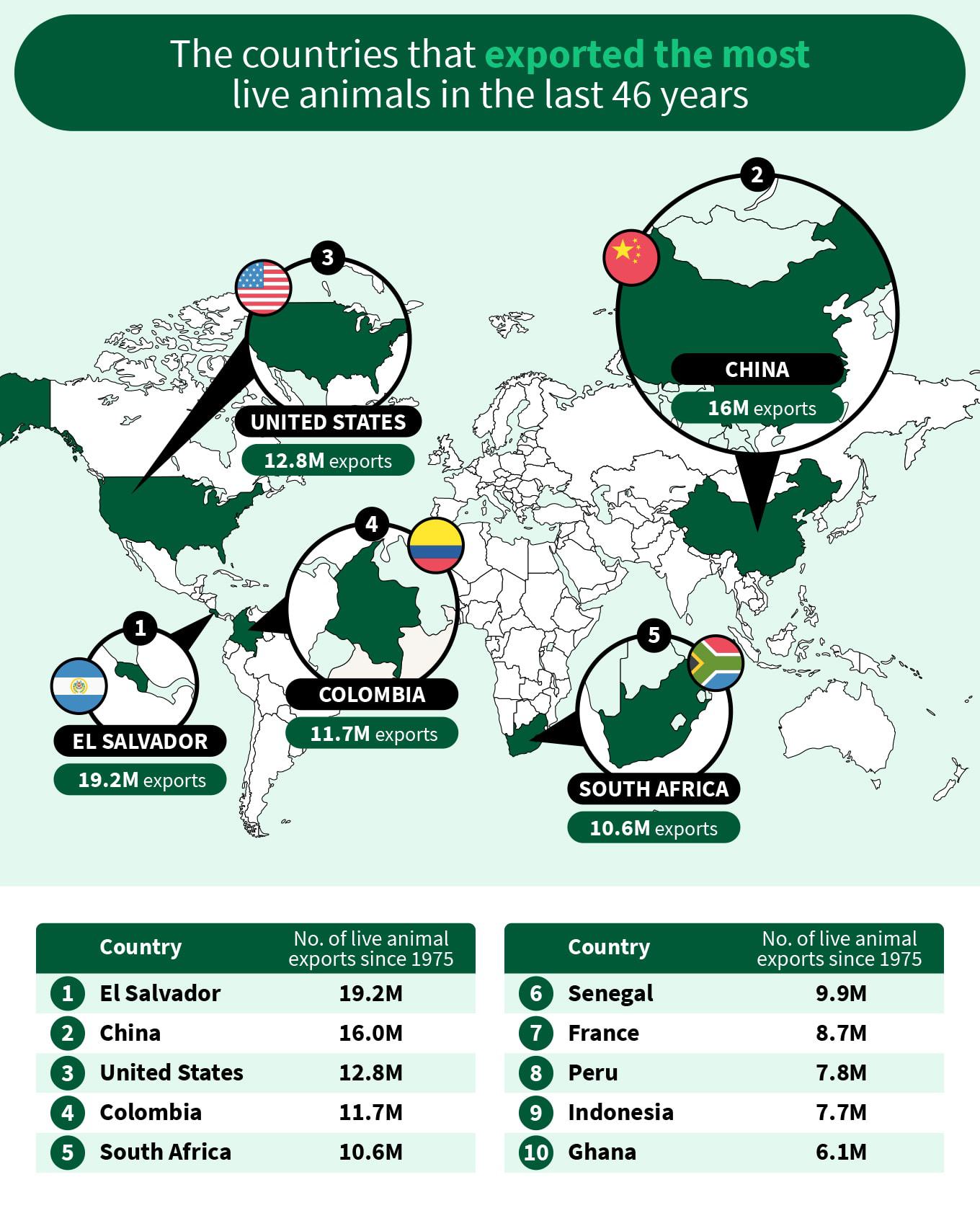
1. El Salvador, 19.2M
The world’s largest exporter of live animals is El Salvador, which has exported over 19 million animals since 1975. Most of their exports are iguana and tortoises.
2. China, 16.0M
Following closely behind is China, which has exported 16 million live animals including sturgeon, pond turtles and monkey species. However, China’s 2020 ban on the trade and consumption of terrestrial wild animals in response to COVID could see their position change in the coming years.
3. United States, 12.8M
The United States’ ranks as one of the biggest exporters of live animals. A significant fraction of all exported animals was made up by iguana and pond turtles – popular choices for pets in the States.
Looking further down this list, it’s clear to see the difference between the number of exported live animals from different countries. The fifth-largest exporter, South Africa, has exported just more than half as many live animals as the clear giant El Salvador.
Some of the largest trading countries have exported just a fraction of the number of animals as the major players. Since 1975, Ghana has exported over 6 million live animals, and for Indonesia and Peru, the figure is close to 8 million.
The Countries That Exported The Least Live Animals In The Last 46 Years
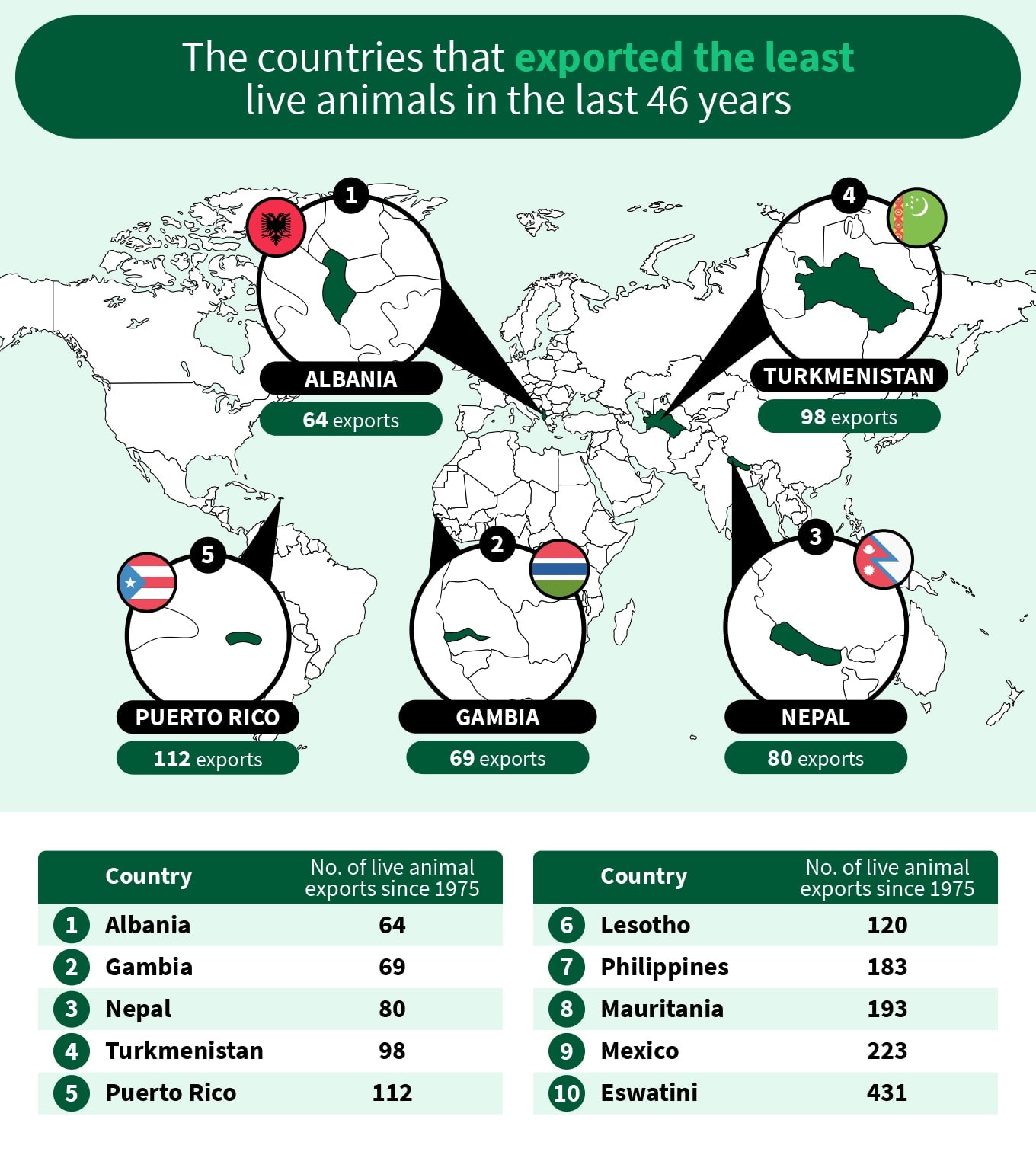
On the other end of the scale, it’s clear to see that some countries are keeping away from the wildlife trading business.
1. Albania, 64
Albania has the lowest number of exports on record, having exported just 64 live animals since 1975. Almost 80% of the animals they transported were turtles, the remainder including coyotes and parrots.
2. Gambia, 69
Gambia has also been little involved in the wildlife export trade – since 1975 they have exported just under 70 live cockatoos and parrots.
3. Nepal, 80
Since 1975 Nepal has only exported 80 live animals. However, the country has been facing a trade deficit across the board, with imports exceeding outports in clothing, food, and oil.
Of Nepal’s total live animal exports since 1975, just under half were Gharials – large semi-aquatic reptiles that resemble crocodiles.
Included in this ranking are the countries with a population of at least 1 million who have traded 50 live animals or more.
The Most Exported Live Animals In The Last 46 Years
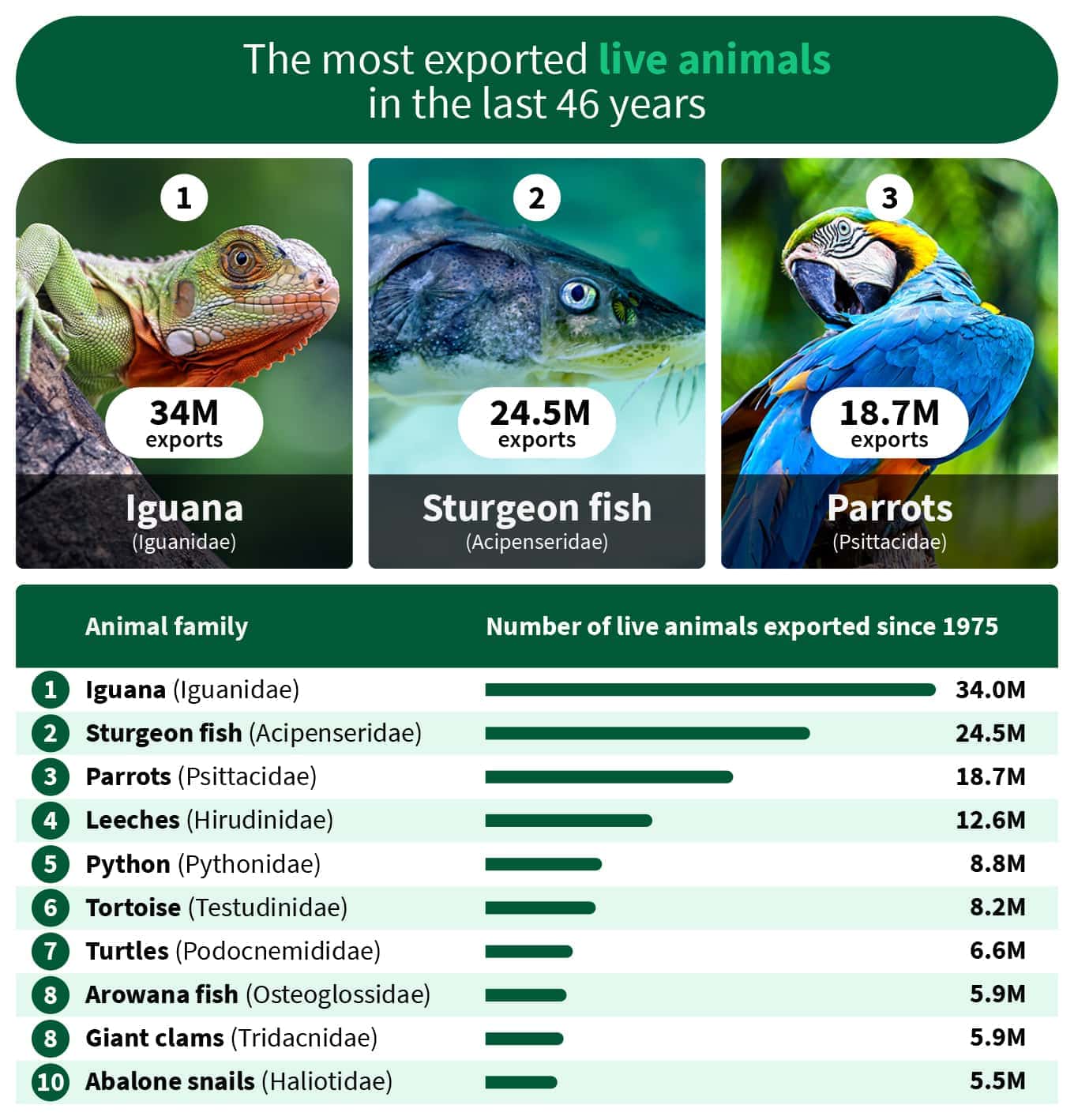
Taking a look at these figures can give us some insight into which animals are being traded.
1. Iguanas, 34.0M
The most exported live animal worldwide since 1975 is iguanas – over 34 million have been traded. Although some were transported to zoos, as investigated below, green iguanas are the most popular imported exotic pet in many countries.
The influx in the iguana trade reached its peak in 1995, when 3 million iguanas were exported worldwide. However, the result of the craze was that most kept as pets died before reaching one year old.
Since the 1990s the amount of iguanas exported worldwide has decreased. From 2017-2019 the average number of exported iguanas per annum was over 200,000.
2. Sturgeon, 24.5M
The next most exported live animal is the sturgeon – which was decreed a royal fish by British royalty in the 1300s. Today, it is the primary type of fish that can produce caviar, so it’s no wonder that over 20 million have been exported across the world.
3. Parrots, 18.7M
The international parrot trade is large and lucrative so it’s no surprise these exotic birds are one of the most traded live animals.
The largest exporting country of parrots is South Africa, yet the Latin American continent dominates this trade. Uruguay and Cuba have exported over 1 million live parrots each since 1975.
The Most Exported Live Animals To Zoos In The Last 46 Years
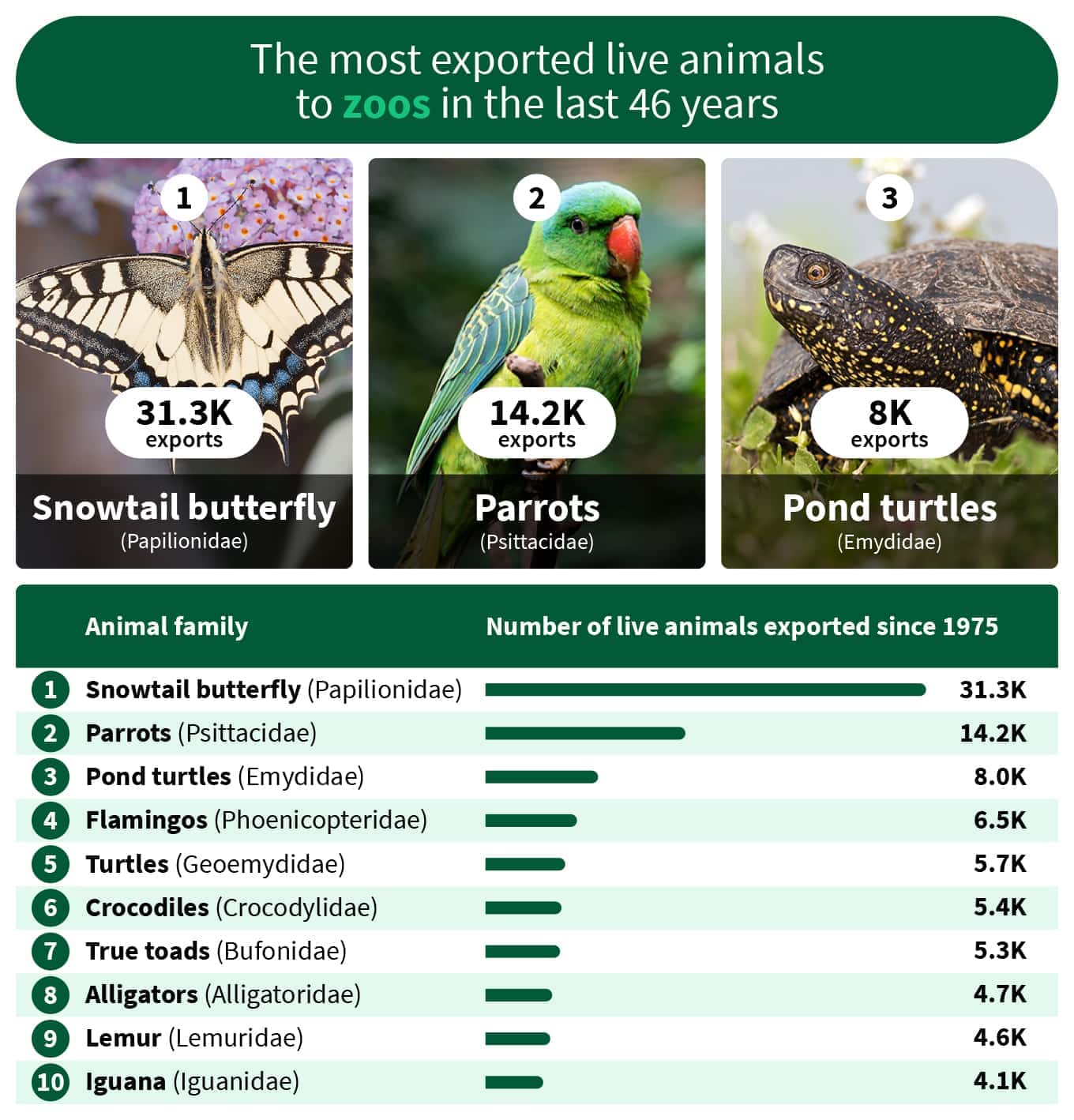
Just over 100,000 of the 200 million total animals traded since 1975 have been sent to enclosures and sanctuaries.
1. Snowtail butterfly, 31.3K
The most common animal to be exported to go to a wildlife enclosure is the snowtail butterfly. With their easy to transport size, and the rise in popularity of ‘butterfly paradises’ in zoos it’s no wonder they rank at the top of this list.
2. Parrots, 14.2K
One of the most popular zoo animals, parrots can be found in almost every wildlife enclosure you visit. Humans have long been fascinated by their ability to imitate sounds and it shows in the figures.
The Most Exported Live Animals Introduced To The Wild In The Last 46 Years
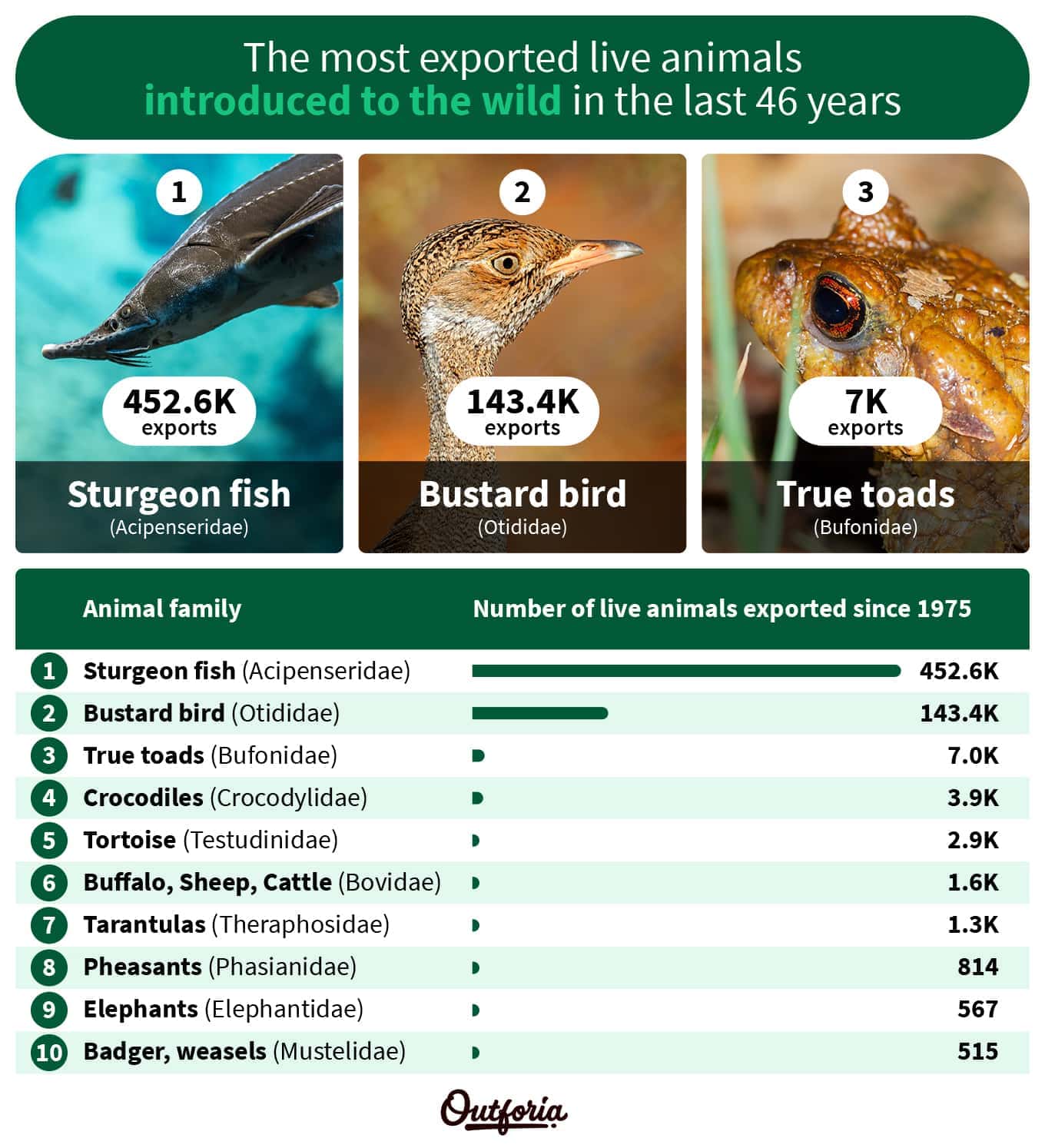
Following guidelines from the CITES 2006 Commission Regulation to protect animals at risk, many countries have taken steps towards animal protection. The United States’ is leading the way having replaced over 200,000 animals to their natural habitat.
1. Sturgeon, 452.6K
As one of the most traded live animals, it’s no surprise sturgeons are the animal most commonly reintroduced to the wild. Heavily traded species are often at risk of threat or extinction, leading to large-scale conservation efforts.
The figures show that over 450,000 sturgeon have been reintroduced to the wild since 1975 which is significantly more than any other live animal.
2. Bustard, 143.4K
An animal at risk of global extinction is the bustard. Largely in danger due to the loss of their natural habitats to roadways, mines and industrial sites, most of the bustard population is in Spain and Portugal.
Since 1975, over 140,000 bustards have been reintroduced to the wild, most of which came from the United Arab Emirates.
Methodology
- We collected all data used from the CITES Trade Database (Convention on International Trade in Endangered Species of Wild Fauna and Flora). The information was filtered to exclude G from purpose and A from the source. The trade term was filtered by term ‘LIV’ to include only live animals. This showed us animal imports and exports, by year, species, purpose, and country. Data on animals reintroduced to the wild was filtered by purpose N and data on animals exported to zoos the data was filtered by purpose Z. Countries with a population of fewer than 1 million, and those who traded less than 50 animals since 1975, were excluded. From the live animal species, living yet non-animal products including flowers and cacti were excluded.
Although the data set is complete, discrepancies may exist due to reliance on CITES’ member states to declare the purpose of each traded item; lack of specification and detail in state-completed reports, and inaccurately recorded quantities of animals e.g. number of crates instead of a number of specimens.
Fair Use Statement
If you’re interested in covering this research, we encourage you to use any of the content included above. We just ask that you attribute Outforia fairly in your coverage and provide a link to our website so that your audience can learn more about our work.







